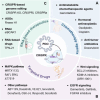Transforming cancer treatment: integrating patient-derived organoids and CRISPR screening for precision medicine
- PMID: 40201690
- PMCID: PMC11975957
- DOI: 10.3389/fphar.2025.1563198
Transforming cancer treatment: integrating patient-derived organoids and CRISPR screening for precision medicine
Abstract
The persistently high mortality rates associated with cancer underscore the imperative need for innovative, efficacious, and safer therapeutic agents, as well as a more nuanced understanding of tumor biology. Patient-derived organoids (PDOs) have emerged as innovative preclinical models with significant translational potential, capable of accurately recapitulating the structural, functional, and heterogeneous characteristics of primary tumors. When integrated with cutting-edge genomic tools such as CRISPR, PDOs provide a powerful platform for identifying cancer driver genes and novel therapeutic targets. This comprehensive review delves into recent advancements in CRISPR-mediated functional screens leveraging PDOs across diverse cancer types, highlighting their pivotal role in high-throughput functional genomics and tumor microenvironment (TME) modeling. Furthermore, this review highlights the synergistic potential of integrating PDOs with CRISPR screens in cancer immunotherapy, focusing on uncovering immune evasion mechanisms and improving the efficacy of immunotherapeutic approaches. Together, these cutting-edge technologies offer significant promise for advancing precision oncology.
Keywords: CRISPR screening; cancer treatment; immunotherapy; patient-derived organoids; precision medicine.
Copyright © 2025 Zhu, Shen, Ho, Hu, Ma and Wang.
Conflict of interest statement
The authors declare that the research was conducted in the absence of any commercial or financial relationships that could be construed as a potential conflict of interest. The author(s) declared that they were an editorial board member of Frontiers, at the time of submission. This had no impact on the peer review process and the final decision.
Figures



Similar articles
-
Patient-derived Organoids in Bladder Cancer: Opportunities and Challenges.Eur Urol Focus. 2025 Jan;11(1):62-70. doi: 10.1016/j.euf.2024.08.008. Epub 2024 Sep 3. Eur Urol Focus. 2025. PMID: 39232905 Review.
-
Patient derived organoids in prostate cancer: improving therapeutic efficacy in precision medicine.Mol Cancer. 2021 Sep 29;20(1):125. doi: 10.1186/s12943-021-01426-3. Mol Cancer. 2021. PMID: 34587953 Free PMC article. Review.
-
Patient-Derived Bladder Cancer Organoids as a Valuable Tool for Understanding Tumor Biology and Developing Personalized Treatment.Adv Sci (Weinh). 2025 Apr;12(13):e2414558. doi: 10.1002/advs.202414558. Epub 2025 Feb 7. Adv Sci (Weinh). 2025. PMID: 39921252 Free PMC article.
-
The use of patient-derived xenografts and patient-derived organoids in the search for new therapeutic regimens for pancreatic carcinoma. A review.Biomed Pharmacother. 2025 Jan;182:117750. doi: 10.1016/j.biopha.2024.117750. Epub 2024 Dec 16. Biomed Pharmacother. 2025. PMID: 39689516 Review.
-
Exploring high-throughput drug sensitivity testing in neuroblastoma cell lines and patient-derived tumor organoids in the era of precision medicine.Eur J Cancer. 2025 Mar 11;218:115275. doi: 10.1016/j.ejca.2025.115275. Epub 2025 Feb 8. Eur J Cancer. 2025. PMID: 39954414 Free PMC article.
Cited by
-
Genetically engineered mouse models in gastric precancerous lesions research.World J Gastrointest Surg. 2025 Jul 27;17(7):107610. doi: 10.4240/wjgs.v17.i7.107610. World J Gastrointest Surg. 2025. PMID: 40740928 Free PMC article. Review.
-
Decoding the role of cancer stem cells in digestive tract tumors: Mechanisms and therapeutic implications (Review).Int J Oncol. 2025 Jul;67(1):61. doi: 10.3892/ijo.2025.5767. Epub 2025 Jun 27. Int J Oncol. 2025. PMID: 40576138 Free PMC article. Review.
-
Exploring Experimental Models of Colorectal Cancer: A Critical Appraisal from 2D Cell Systems to Organoids, Humanized Mouse Avatars, Organ-on-Chip, CRISPR Engineering, and AI-Driven Platforms-Challenges and Opportunities for Translational Precision Oncology.Cancers (Basel). 2025 Jun 26;17(13):2163. doi: 10.3390/cancers17132163. Cancers (Basel). 2025. PMID: 40647462 Free PMC article. Review.
References
Publication types
LinkOut - more resources
Full Text Sources

